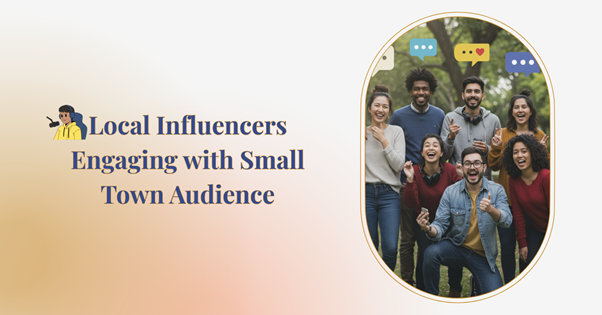Introduction
Even smaller communities are getting in on influencer marketing’s major impact. With rising internet penetration and smartphone use in non-metro and rural areas, local influencers—often micro or nano creators—are reshaping how small-town businesses connect with audiences . But success depends on knowing what drives trust, authenticity, and ROI in these unique environments.
What Works ✅
- Local Micro‑ & Nano‑Influencers
Local creators with a few thousand highly engaged followers often outperform national celebrities in small towns. These influencers speak the local dialect, share community stories, and have built-in trust .
Example: BGauss’s hyper-local Diwali campaign used regional micro-influencers, resulting in high engagement and brand loyalty .
- Community Ambassadors Over Paid Celebrities
Ambassadors—local regulars who genuinely love your product—provide authentic recommendations. Gymshark and Synergym saw strong results this way, paying €4–5 per ambassador vs. expensive celebritie.
- Regional Language & Cultural Relevance
In India, content in native languages connects better with small-town audiences. Brands report 75% now use regional influencers, especially micro/nano, for more effective engagement.
- Relationship-Driven Collaborations
Effective campaigns are built on relationships and clear expectations. Local influencers often collaborate for products, experiences, or small fees—rather than high cash payments .
- Cross-Promotion & Local SEO
When influencers tag your business, add local hashtags, or link directly to your site, your brand gains better local search visibility.
- Real-World Campaign Activations
Offline events—even guerrilla marketing—can generate organic buzz. In small towns, print ads and local events still matter .
What Doesn’t Work ❌
- Big-City Influencers with Fake Engagement
High-follower influencers may lack genuine small-town connections and can have low-quality, fake engagement .
- One-Off Paid Campaigns Without Follow-Up
Short campaigns with limited planning often fail to build momentum. Consistency and community focus are key .
- Ignoring Cultural Context
Urban content styles—or messaging that misses community sensitivities—don’t resonate. Tailored messaging is essential
- Overlooking Tracking and ROI
Many small-town campaigns underperform due to poor tracking: no unique codes, GA setup, or influence on foot traffic .
Case Studies & Insights
| Project / Location | Approach | Results |
| ReTreet Resort (Alabama) | Weekly influencer visits plus curated amenities & local partnerships | Occupancy doubled, ROI $28 per $1 spent . |
| BGauss Diwali Campaign | Festive product integration using regional micro‑influencers | High engagement and localized resonance |
| Puranik Builders (Thane, India) | Local micro-influencers for Instagram that highlighted lifestyle | 1.37% engagement, purchase-intent signals |
| Vita Coco (NYC) | Shift from influencer gifts to community event activation | Strong organic buzz and deeper brand authenticity |
Best Practices for Small Town Brands
- Identify local micro/nano influencers using manual discovery or agencies.
- Form genuine partnerships, offering value through products, experiences, or exposure.
- Use unique tracking: coupon codes, UTM links, on-site surveys, or event RSVPs.
- Communicate culturally relevant narratives in local dialects and familiar idioms.
- Integrate online + offline activations, like community pop-ups or sponsorships.
- Maintain consistency: multiple collaborations create ongoing momentum.
FAQs
Q: How many followers should a small-town influencer have?
A: Between 1K–50K, but engagement matters more—look for meaningful interaction levels
Q: How do I measure campaign success?
A: Use tracking codes, monitor foot traffic changes, engagement rates, and sales spikes during campaigns .
Q: Should I focus on paid or product-only collaborations?
A: If budgets are small, start with product or experience exchanges. Paid incentives work too—but ensure clear expectations .
Q: Are print and offline still useful?
A: Absolutely. Local print ads, events, and posters drive awareness and complement digital efforts .
Conclusion
Influencer marketing in small towns thrives on authenticity, cultural fit, consistent engagement, and measurable results. Skip big-city celebrities and instead tap into trusted local voices. Start with micro-influencers or brand ambassadors, build relationships, blend online-offline tactics, and always track ROI.
When done right, even modest micro-influencer campaigns in small towns can deliver strong engagement, foot traffic, and sales—and sometimes, surprise the brand with exponential attention.








